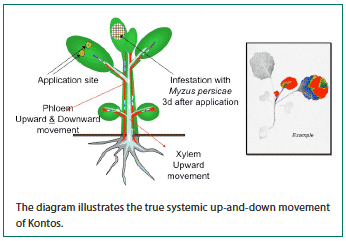Kontos: a product for today and the future
By Dr. Carlos Bográn, OHP technical service manager
Sustainable crop production in the era of environmental awareness will require tools that are not only effective and economically feasible but also those that pose little or no risk to non-target organisms and our fragile ecosystems. The unique characteristics of OHP's Kontos® Insecticide make it one of those modern tools for prevention of pest-derived damage in production horticulture today. Whiteflies, mealybugs and scale insects feed by piercing into the plant's tissues and feeding on sap or cellular contents.
Control of these and other key pests such
as thrips and aphids often requires the
timely application of a systemic insecticide.
Systemic insecticides are incorporated
by the plant after application and
move from treated surfaces to untreated
ones, thus providing better protection
than contact-insecticide sprays.
Whether or not an insecticide moves
within the plant and the speed at which it
moves is based on both the chemical and
physical properties of the molecule and
the size (and transporting mechanism) of
the plant. 
All systemic insecticide molecules available today can move acropetally (towards the tips of the plant) via the xylem but, often because they are highly water-soluble, do not effectively move basipetally (towards the base of the plant) in the phloem. Kontos (spirotetramat) is a true systemic insecticide; once in the plant, it converts into a molecule with the perfect combination of characteristics for xylem and phloem mobility. Even though the compound is not very water-soluble, it is a weak acid with intermediate membrane permeability which allows it to slowly diffuse through, accumulate into and get moved in the phloem tissues. No other insecticide available today is able to move 'up and down' the plant and provide complete protection against key pests.
Kontos is also friendly to our environment. Since it works within the plant tissues, it is not toxic to insects and other animals that do not feed directly on the plant's sap. Also, since it works by inhibiting lipid (fat reserves) synthesis in the developing insects it has little effect on most adult predators and parasitoids that have already developed these fat reserves. Therefore, Kontos is highly compatible with biological control programs within an integrated pest management (IPM) strategy. Kontos is very quickly degraded by microorganisms in the soil and on the plant surface and it is used at such a low concentration (less than 0.03% by volume) that the chemical load on the environment is very low compared to traditional chemistries. Kontos should be used early in the crop cycle to prevent pest damage and not as a rescue treatment. It takes time for the product to reach lethal concentrations within the xylem and phloem tissues and to get translocated through the plant.
Applications targeting small initial pest populations not only are more effective but also minimize aesthetic damage and plant losses. Because of its unique characteristics and excellent environmental attributes, Kontos is truly the first compound of its kind.
